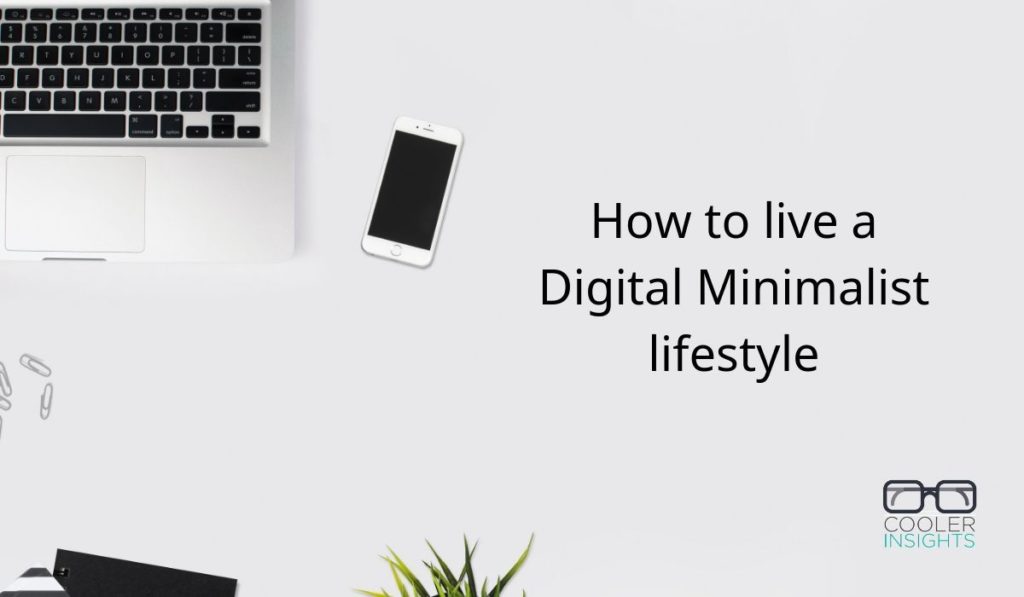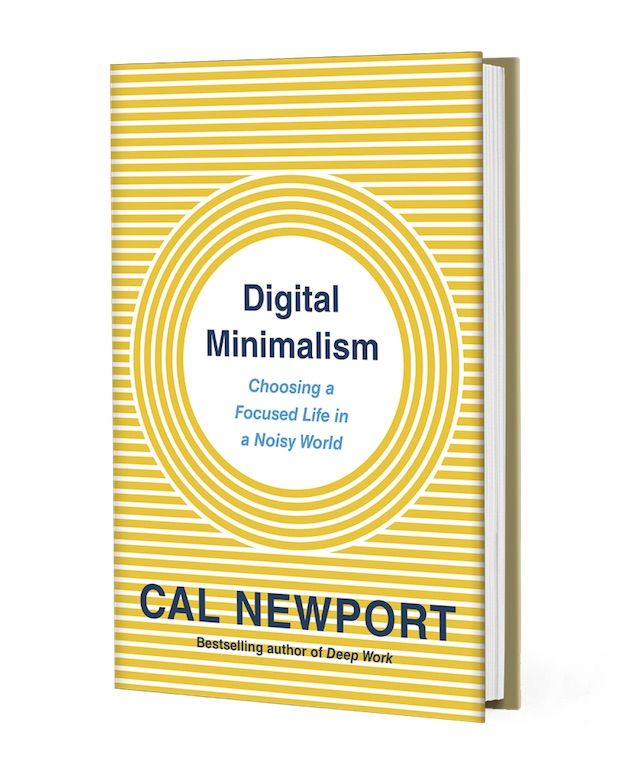
Smartphones and social media are both a boon and a bane.
As a social media marketer, I love the opportunities which blogs, Facebook, LinkedIn, YouTube, Instagram, WhatsApp and Pinterest offer to me. My current lifestyle as an online entrepreneur is largely possible due to the affordances provided by social technologies.
Yet, I am also mindful of the dangers of digital addictions.
Coining them “Irresistible,” psychology professor Adam Alter warned that the potent mix of smartphones and social networks can be disastrous to our abilities to concentrate, equating them to “digital cocaine.”
Former Google engineer Tristan Harris called the smartphone a “slot machine.”
To learn how to better balance my own digital diet, I recently picked up the book Digital Minimalism—Choosing a Focused Life in a Noisy World by Cal Newport.
A computer science professor at Georgetown University, Cal does not have any social media account—no Twitter, no Facebook, or Instagram.
(He does have a pretty active blog though, and is a prolific writer.)
Covering wide areas of research peppered with numerous examples, anecdotes and case studies, Digital Minimalism proposes that applying the principles of minimalism to personal technology can help us to lead richer, more meaningful and focused lives.
Let us look at what its key tenets are.
What is Digital Minimalism?
A radical philosophy birthed to resist the “lopsided arms race” forged by the “gods” of Silicon Valley, digital minimalism is defined by Newport as follows:
Digital Minimalism: A philosophy of technology use in which you focus your online time on a small number of carefully selected and optimized activities that strongly support things you value, and then happily miss out on everything else.
There are three core principles underpinning digital minimalism:
- Clutter is costly: Too much time and attention spent on multiple devices, apps, and services exerts an overall negative cost.
- Optimization is important: Think carefully about how you use a technology, and only use something that is valuable.
- Intentionality is satisfying: Be more intentional about technology use, and you’ll derive more satisfaction and meaning from them.
So how can you live a digitally minimalist lifestyle?
Digital Decluttering
Imagine Marie Kondo going through your apps and digital devices. What would she discard?
While Newport may not advocate #sparkingjoy the same way as Kondo, he does recommend some pretty useful steps to consider.
#1 Define How You Use Technology
Come up with a simple operating procedures (aka SOPs) on how you should use technology. Determine which are optional and which are necessary. Come up with a list of banned technologies. Write it down and put it somewhere where you can see it everyday.
#2 Take a 30-Day Break
Yes, this is far more radical than just a digital detox weekend!
To make this work for you, you are urged to “rediscover what’s important to you and enjoy outside the world of the always-on, shiny digital.”
#3 Reintroduce Technology
Do not bring all technologies back en masse. Rather, use the following screening test to decide if the technology qualifies to have a role in your life:
- Does it serve something you deeply value?
- Is the technology the best way to serve this value? (If not, replace with something better)
- Specify when and how you will use the technology for a specific role in your life
Embrace Solitude
Do you know that US president Abraham Lincoln used to commute every day to a lonely cottage away from the capital to have time to think?
The cottage provided the setting where “Lincoln wrestled with the Emancipation Proclamation,” resulting in the eventual freedom granted to all African Americans who no longer needed to live as slaves.
Like Lincoln, you need time alone to think, reflect and create. There are several practices you can apply here:
- Leave your phone at home: Make time to be unplugged and off-the-grid
- Take long walks: Both acclaimed philosopher Friedrich Nietzsche and Apple founder Steve Jobs are huge proponents of this
- Write a journal: No, not a blog like this, but a physical paper journal like a Moleskine notebook
Don’t Click “Like”
The paradox of the social media age is that the more connected we are, the more alone we may feel. Here, I’d like to introduce Sherry Turkle’s famous TED talk where she spoke emphatically about this phenomenon:
This is not to say that social media is all bad. On the contrary, social media can play a vital role in connecting us with others.
The danger, however, lies in overusing social media to the extent of crowding out our real life relationships.
To reclaim conversation and go beyond superficial connections, Newport suggests the following:
- Don’t click like: Refrain from just clicking and approving your friend’s posts. Don’t even comment on their posts. Just remain silent.
- Consolidate texting: Batch process your WhatsApp, Messenger and other textual intercourse
- Hold conversation office hours: Set aside specific times every day where people can call you on the phone or meet you face-to-face to talk
Pursue Productive Leisure
High-quality leisure is the name of Newport’s game here.
#1 Demanding Activity > Passive Consumption
If you wish to relax, make time to prioritize demanding activity over passive consumption. This could mean building your house, fixing your car, or writing a book as opposed to binge-watching YouTube videos (something I’m guilty of.)
#2 Learn Physical Crafts
Focus on learning new skills. Be a craftsperson. Use your skills to produce valuable things in the physical world.
#3 Join Social Groups
Be part of a community. Seek activities requiring real-world, structured social interactions. This can be knitting, cross-fit, model-building, or whatever leisure you’re keen on.
#4 Fix or Build Something Weekly
Use your hands to learn and apply a new skill every week for a period of six weeks.
This can be from installing new lights, changing your car oil, learning a new musical instrument, to starting a high-rise garden.
#5 Follow a Leisure Plan
Be serious about your leisure pursuits, and come up with a leisure plan. This should be both seasonal and weekly (where you schedule them into your calendar.)
Here’s an example:
- Objective: To write a book on exercise for middle-aged men in 6 months
- Strategies: Read books on fitness for mature adults; Set time to write a page or two every day; Publish eBook in December with a launch party
- Habits: Read a book every night for 30 minutes; Limit low-quality leisure to 60 minutes a day; Participate in a fitness programme every week
Join the Attention Revolution
The final chapter amounts to a battle call.
Here, Newport urges readers to “join the attention resistance” by resisting the siren songs of technology behemoths intent on making us “products” to be sold to advertisers.
There are four practices which he advocates here:
#1 Delete social media from your phone
This isn’t as radical as it sounds as I do know some associates who practice it. Doing so can help you to escape from the “ominous feedback loop” designed by “attention engineers” in tech companies who wish to make their mobile apps sticky.
#2 Turn your devices into single-purpose computers
Remember the days where your music player is a Walkman, your video screen is your TV, and your word processor is your computer?
While moving back to a simpler age may not be possible, Newport advocates that you use apps to block distracting websites and applications.
#3 Use social media like a professional
This totally resonates with me. As a social media marketer and content marketer, I have to spend a fair amount of time online and the tips here are useful:
- Curate your feeds to focus on professional content from industry thought leaders
- Follow a small number of communities related to your interests
- Occasionally log on to see what’s happening on each network, but limit your feed to those from your close social circles
#4 Revert to slow media
Heard of the Slow Food movement? Well, the Europeans have now created a Slow Media movement which is predicated on being purposeful and intentional in consuming content.
The goal is to avoid the automatic response of scrolling through endlessly on your feeds. Instead, set aside specific time to consume news and information from specific websites, and break away from the “frantic cycle of clicking.”
And yes, this could mean bringing back the old-fashioned paper newspaper!
#5 Use a dumb phone!
Apparently, dumb phones are a thing now. New products like the Doro PhoneEasy—a basic clamshell flip phone with oversize buttons and big-font display, have entered the market.
As living without a smartphone may be impossible for some, the other less draconian strategy is to cleanse your phone of most of its apps. Leave only the most vital for purely communication purposes.
Conclusion
As a digital marketer who runs a content marketing and social media agency, I need to be plugged into the latest developments in the online world.
At the same time, balancing between the online and offline time is a constant challenge and struggle.
Thanks to Digital Minimalism, we now have a way to deal with this dilemma.
While I may not adopt as drastic an approach as that prescribed by Professor Cal Newport, I’d probably start practicing better control over my digital dietary habits.
What about you? How can you better manage your digital life, and which principles of digital minimalism would you adopt?


I just like the helpful information you provide in your articles. I will bookmark your blog and take a look at once more here regularly.
I am somewhat certain I’ll be informed plenty of new stuff right here! Good luck for the following! Japanese Language Classes